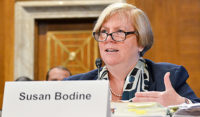U.S. Environmental Protection Agency strategy since 2017 to prioritize compliance with U.S. environmental laws over enforcement—as well as budget and staff shortages and management decisions in the last decade—have led to fewer enforcement actions and lower penalties, says the agency inspector general in May 12 and May 13 reports. COVID-19 issues also have been a recent factor.
Between 2007 and 2018, there were 58% fewer enforcements with injunctive relief, and 48% fewer both with penalties and with supplemental environmental projects, according to one IG report The falloff led to a decline in the cleanup of pollution and a drop in emission reductions, the watchdog says.
A major cause of the declines is an 18% inflation-adjusted drop in funding for EPA’s enforcement program, which led to a 21% staffing cut, even as the agency was tasked with enforcing additional laws in a growing economy.
“At a time when the need for EPA oversight and enforcement increased, [agency] capacity to meet that need decreased,” the IG said. Staff reductions often affected the most experienced employees, with the agency struggling to maintain consistent levels of enforcement actions, according to its report.
Decision-Making Cited
“EPA leadership also made strategic decisions that affected enforcement trends, such as focusing limited resources on the most serious cases and, in 2017, emphasizing deference to state enforcement programs and compliance assistance,” the IG said. As a result, noncompliance with environmental laws and regulations may have gone undetected or unaddressed, with reduced enforcement “incentivizing industrial facilities to forego essential pollution control measures,” the report says.
According to a review of fiscal 2019 and 2020 data, the IG found 11 out of 15 national enforcement measures continuing to decline. The coronavirus pandemic also “likely affected the overall long-term downward trend of EPA enforcement activities in fiscal 2020,” the IG said.
The watchdog found that gaps in agency tracking of enforcement efforts and noncompliance rates made it impossible to assess the full scope and effectiveness of the enforcement program. The IG recommended that EPA add enforcement information in its annual reports to show environmental benefits achieved.
Workplace Culture
In the other audit spurred by a hotline complaint related to EPA’s Office of Criminal Enforcement and its national enforcement investigations center, the IG noted remaining concerns about staffing shortages and trust in management even after previous audits and agency corrective actions. The center, located in Lakewood, Colo., provides forensic, scientific and technical support through field work and lab analysis for EPA criminal and civil environmental investigations.
Many center managers have changed since 2016, with the IG noting, according to interviews with staff, a general lack of confidence and trust "specifically in ... senior management,” which triggered the departure of many employees. According to the report, “management does not emphasize safety, quality and environmental management; rather, it emphasizes getting things done.”
The IG said while enforcement units are addressing past safety and health audit findings, "we also identified multiple concerns associated with required internal reviews not conducted, hazardous waste mismanagement and noncompliance with safety incident reporting procedures."
The watchdog said it clarified some findings based on EPA response, but "ultimately, we stand by our conclusions. It is apparent from our interviews of current and former employees, ... that fear of reprisal exists.”
House Transportation and Infrastructure Committee Chair Peter DeFazio, whose committee has Clean Water Act enforcement jurisdiction, said In a statement, that the IG report "is extremely troubling and demands a course correction in short order to ensure EPA’s mission ... doesn’t see further degradation."
The agency has moved forward in recent days to rescind two Trump administration actions, including Federal Register publication set for May 18 of a final rule to overturn one from last October that enabled anyone to participate in modifying or withdrawing agency guidance documents. “EPA has concluded that the internal rule on guidance deprives [it] of necessary flexibility in determining when and how best to issue public guidance based on particular facts and circumstances, and unduly restricts EPA's ability to provide timely guidance on which the public can confidently rely.” EPA says it will still make agency guidance available to the public, seek input and allow stakeholders to petition the agency to issue, amend or repeal guidance.
In a separate action, EPA pulled a December 2020 rule that altered the way the agency determines costs and benefits for clean-air regulations. The Trump cost-benefit rule was “untethered to the U.S. Clean Air Act," lacked a "rational basis,” and did not justify how a previously existing rule would have created “inconsistent outcomes,” according to a May 14 Federal Register notice that officially rescinds the regulation.






Post a comment to this article
Report Abusive Comment